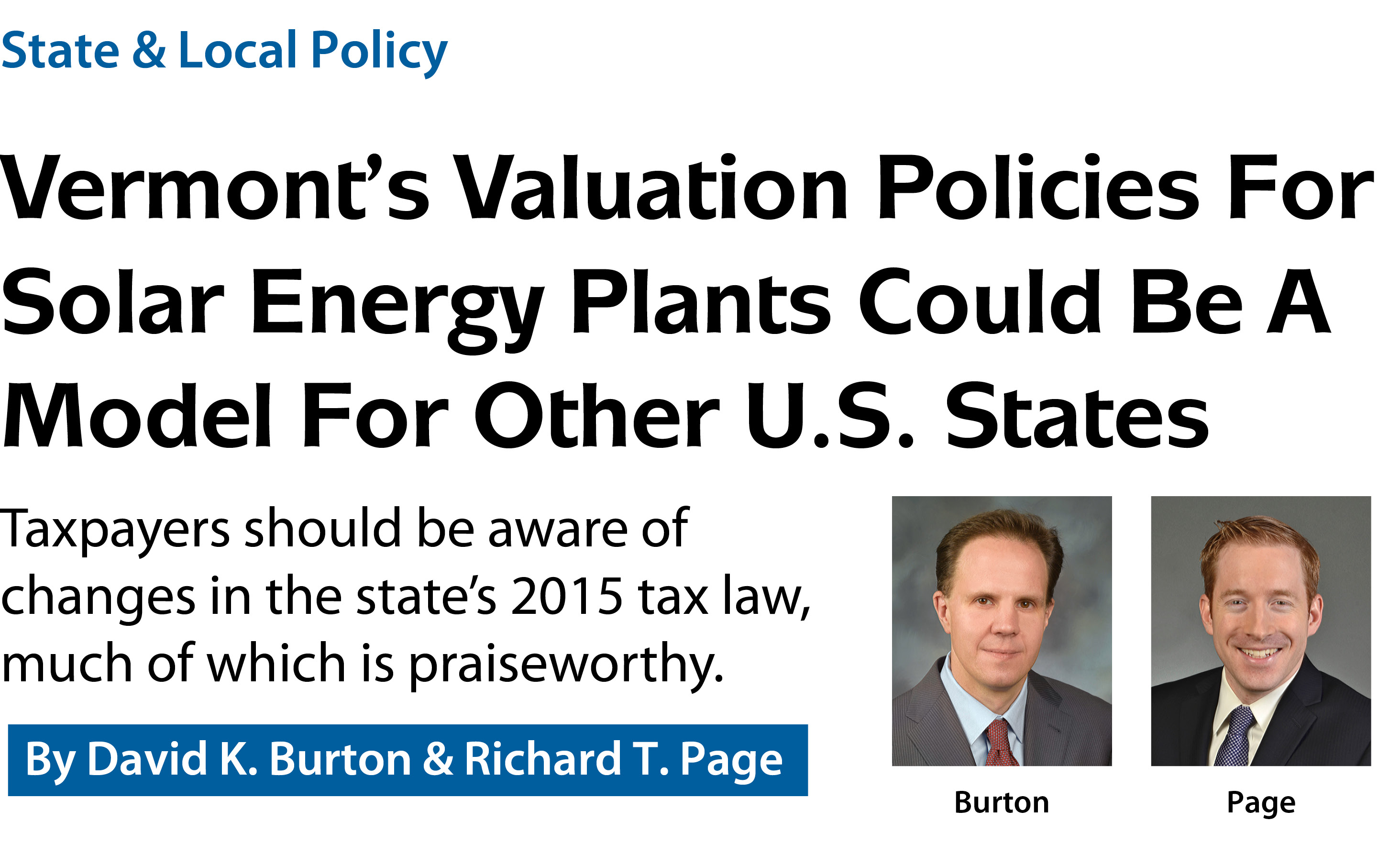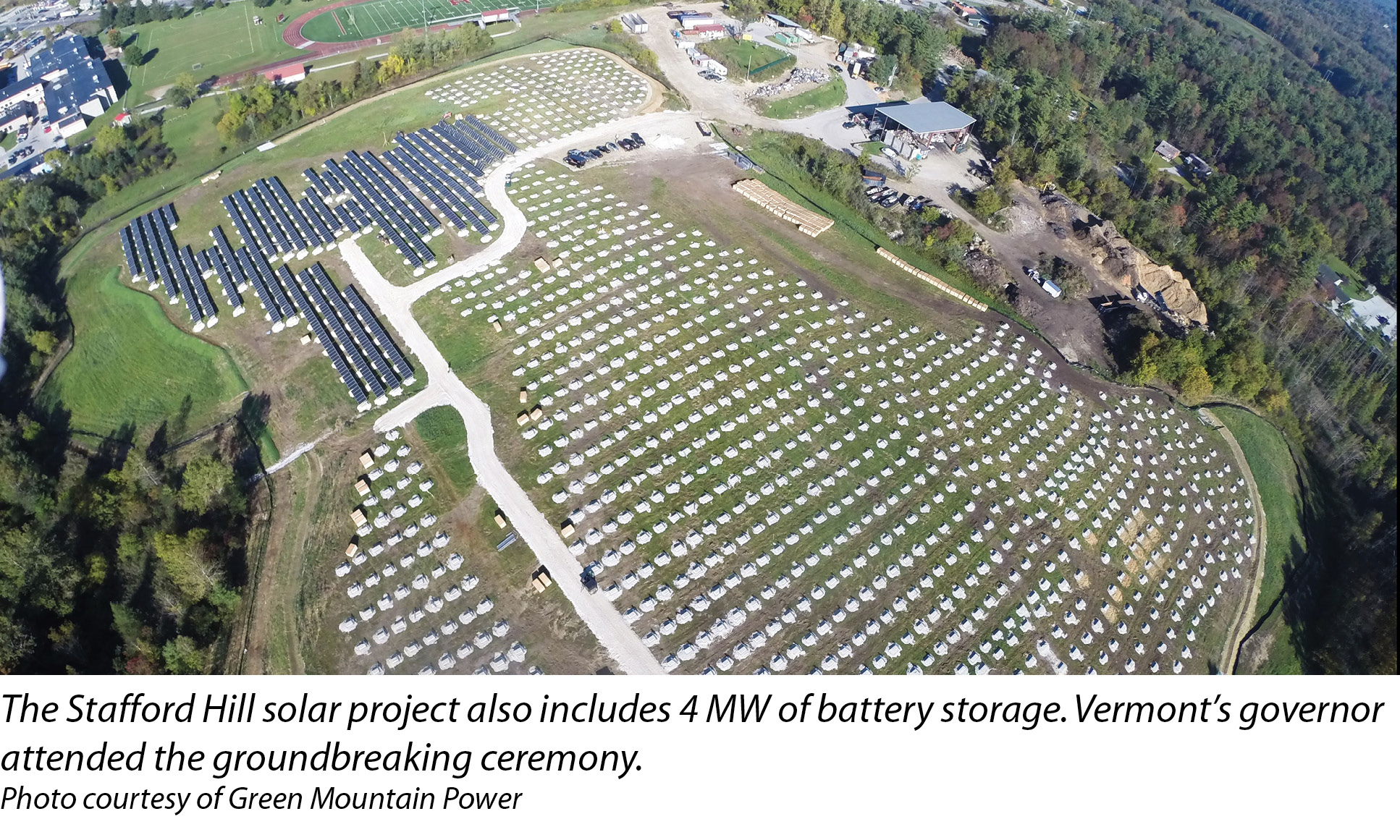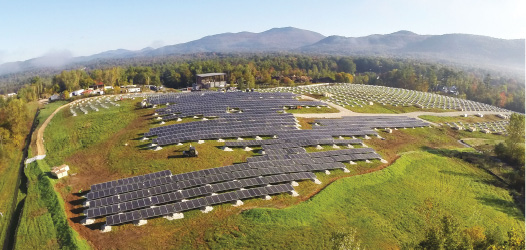

301 Moved Permanently
The Vermont Department of Taxes has issued a fact sheet for taxpayers to help clarify how solar energy plants are taxed in the state.
The 2015 Fact Sheet directs taxpayers to use an online financial model to value solar energy plants that are subject to property taxes. By providing this valuation model, Vermont is in the vanguard of state-level solar energy tax policy.
The practical, standardized nature of the model promotes both the efficiency and fairness of Vermont’s tax system. Taxpayer use of this model, which is managed by a third-party contractor, should be considered by tax administrators in other states. Moreover, adopting a similar valuation model for state and federal income tax purposes could minimize taxpayer disputes with the U.S. Internal Revenue Service and other tax authorities.
Solar energy property
Vermont now requires solar energy plants in the state with a capacity of 50 kW or more to pay an annual Uniform Capacity Tax of $4/kW of plant capacity. The Uniform Capacity Tax is due no later than April 15 for the preceding calendar year. Note that when this Uniform Capacity Tax was first enacted as part of Vermont’s 2012 legislative session, the threshold capacity for application of the tax was 10 kW per plant. The new 50 kW threshold is effective beginning with the 2015 tax year.
Plants meeting or exceeding the 50 kW threshold are exempt from the state’s education property tax. Plants that fall below the 50 kW threshold and that are either (a) employing a net-metering system or are (b) off grid and providing energy to one property are now exempt from the following:
- The Uniform Capacity Tax;
- The state’s education property tax; and
- Municipal property taxes.
For plants that do not automatically qualify for the municipal property tax exemption as described above, such an exemption is still possible by requesting that one’s municipality approve an exemption by a vote at a town meeting pursuant to the Vermont Statutes, Title 32 Section 3845 (32 V.S.A. 3845), or by negotiating a contract with the respective municipality to stabilize property taxes pursuant to 24 V.S.A. 2741.
A plant’s capacity is determined by relying on the plant’s certificate of public good, unless a taxpayer can demonstrate that an alternative calculation is more accurate.
Taxpayers may be tempted to try to define related solar projects as separate plants in an attempt to appear to be below the 50 kW threshold. However, Vermont has anticipated such a move and, accordingly, the 2015 Fact Sheet notes that “a group of solar-generating facilities is considered one ‘plant’ if the group is part of the same project and uses common equipment and infrastructure, such as roads, control facilities and connections to the electric grid.”

The valuation model
Solar energy plants that are not exempt from both municipal property taxes and the state’s education property tax must be valued using a discounted cashflow (DCF) method pursuant to 32 V.S.A. 3481. The DCF method is intended to provide a taxpayer with the fair market value (FMV) of the relevant solar equipment. Taxpayers must use the online solar energy plant valuation model that has been approved by Vermont. The online model uses algorithms developed by the Sandia National Laboratories.
Several factors in the valuation model cause the method to produce relatively low valuations of solar energy plants. Lower valuations for property tax purposes encourage taxpayers to invest in solar projects but would not be appropriate for taxpayers in an income tax context where a true valuation is needed to determine tax credits and depreciation.
The factors Vermont uses that result in lower valuation metrics include the following: a high discount rate for DCF purposes, the exclusion of federal investment tax credits (ITCs) earned and federal accelerated depreciation taken, a relatively short estimated life of the equipment, and a gratuitous 30% valuation reduction.
A critical factor in the DCF method is the discount rate. The online valuation model permits a user to enter its own discount rate because the model’s use is not limited to property tax valuations. Vermont’s instructions are less than completely clear; however, it appears that Vermont mandates using a 13.31% base discount rate.
If a discount rate was not mandated, the taxpayer could enter a discount rate of 90%, for example, which would result in the solar energy plant having a de minimis value with a resulting de minimis property tax bill. Thus, the instructions appear to be mandating a discount rate, rather than merely suggesting one by example.
In the current low-interest-rate environment, a 13.31% discount rate is relatively high. A high discount rate favors the taxpayer because it results in a lower FMV subjected to property taxes. Thus, it is not clear if Vermont selected 13.31% because it believed that to be an appropriate discount rate for solar energy plants or because it wanted to repress valuations to encourage investment in solar energy plants.
Generally, appraisers apply an after-tax weighted-average cost of capital (WACC - pronounced as “whack”) calculation to determine an appropriate rate to discount after-tax cashflows in a DCF valuation, as is recommended by valuation experts. Sometimes, it is appropriate to use an industry WACC for a business that has a very similar risk and financing profile in relation to a given industry.
We have seen WACC calculations for this industry in the range of 4% to 7%. The WACC approach to determining discount rates would be more appropriate than the model’s current approach if this model were used to value property for income tax purposes.
Further, the online model appears to be valuing only pre-tax cashflows because, in the example provided, no federal ITC or accelerated depreciation incentives appear to be factored into the first year’s cashflow.
The 30% federal ITC that solar projects are currently eligible for does not appear to increase the valuations calculated by the online model, and this omission further reduces the FMV and, accordingly, taxpayers’ property tax bills for solar projects. Likewise, the model does not appear to reference depreciation deductions related to the federal Modified Accelerated Cost Recovery System.
If this valuation model were used for income tax purposes in states that offer state tax credits for solar energy projects (e.g., North Carolina), receipt of such credits would also need to be factored into valuation calculations.
Additionally, the DCF valuation is premised on an expected 25-year project life. No explanation is offered for the estimated useful life of 25 years; however, the default warranty period for the model is 25 years, so the estimated useful life could be tied to that. This is the equivalent of saying that a car has an estimated useful life of five years because the car comes with a five-year warranty.
It is important to note that it has become commonplace for appraisers to apply an estimated useful life of 30 to 40 years to solar energy equipment. Furthermore, there are solar panels that were manufactured in the 1970s and 1980s that are still operating.
Finally, the 2015 Fact Sheet notes that the appraisal value ultimately determined for property tax purposes should be equal to 70% of the DCF valuation calculation produced by the online model. This 70% factor reduces the valuation by 30% and further encourages Vermont taxpayers to construct solar energy plants.

Model policies
We are not advocating for Vermont to change any of the factors above because the model is being used to value solar energy plants for property tax purposes, and the factors above create relatively low valuations that encourage investment in solar energy equipment in the state.
In fact, we are so impressed with Vermont’s approach to solar energy property valuations that we encourage other tax authorities to consider whether an online model would be feasible for them to deploy. Such an online model would provide greater certainty to taxpayers and reduce the time and expense of tax disputes.
If tax authorities apply this online valuation approach to solar energy property for income tax purposes, the factors we delineated above will need to be adjusted in order to avoid generating valuations that are inappropriately repressed. In the context of income taxes, low valuations of solar energy property would generally discourage investment in such property because related tax credits and depreciation deductions would be proportionately repressed - except in instances in which the taxpayer constructed the solar project itself and its tax basis is determined by its out-of-pocket expenditures for equipment and labor. S
State & Local Policy
Vermont’s Valuation Policies For Solar Energy Plants Could Be A Model For Other U.S. States
By David K. Burton & Richard T. Page
Taxpayers should be aware of changes in the state’s 2015 tax law, much of which is praiseworthy.


si body si body i si body bi si body b
si depbio
- si bullets
si sh
si subhead
pullquote
si first graph
si sh no rule
si last graph